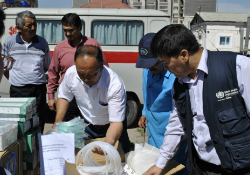Health emergency preparedness in Kyrgyzstan

WHO/Kubanychbek Monolbaev
WHO has been providing assistance to Kyrgyzstan in all emergency situations for more than 20 years. Currently, its focus is on helping the country scale up implementation of the International Health Regulations (IHR) (2005), build capacity for dealing with disasters and improve preparedness for infectious disease outbreaks.
The IHR are the main tool for preventing and responding to global epidemics in the field of public health. WHO has been promoting the widespread implementation of the IHR in Kyrgyzstan and contributing to the improvement of epidemiological surveillance since 2012. In the last 2 years, WHO assisted the country in evaluating its IHR functions and helped develop a national emergency risk communication plan.
As a mountainous country, Kyrgyzstan frequently suffers from natural disasters such as earthquakes, avalanches, mudflows and landslides. On average, the country experiences 200 emergency situations every year. Over the past 2 decades, Kyrgyzstan also saw 2 revolutions and interethnic conflicts in its southern regions. WHO works side by side with the national health authorities to improve the national health system’s preparedness for such crises.
In 2016–2017, WHO helped assess the safety of 70 national hospitals and produce a hospital safety index, which indicates levels of preparedness for providing services during emergencies. It also supported the country in developing a training programme for representatives of national authorities from different sectors to improve the coordination of activities and the exchange of information in emergencies. As a member of Kyrgyzstan’s Disaster Response Coordination Unit, WHO participates in emergency simulation exercises.
The joint efforts of the national health authorities, WHO and other development partners to strengthen Kyrgyzstan’s preparedness for emergencies have proven fruitful in the face of infectious disease outbreaks. During a bacterial meningitis outbreak in 2013–2014 and a measles outbreak in 2014–2015, the country responded quickly and effectively. WHO assisted during the meningitis outbreak by strengthening laboratory capacity, and during the measles outbreak by contributing to a massive immunization campaign targeted at children and adolescents.
In 2017, as part of its ongoing support to improve Kyrgyzstan’s outbreak preparedness, WHO provided guidelines on outbreak investigation and response. As laboratories play an essential role in detecting and controlling infectious diseases and preventing outbreaks, improving the quality of laboratory services and strengthening national laboratory capacity are key elements of this work.
Influenza pandemic preparedness is a particular focus, as influenza sparks every year during the cold season in Kyrgyzstan. Over the past 2 years, WHO helped develop a pandemic influenza preparedness plan, strengthen influenza surveillance in the country, and train specialists on epidemiological and laboratory surveillance and clinical management.



